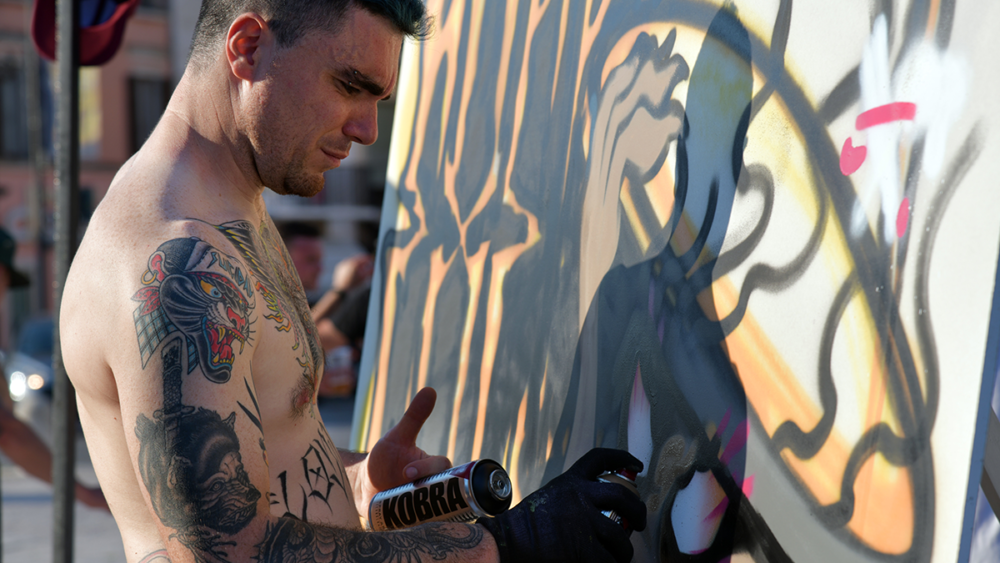Street Art: Drawing the line between art and vandalism

Street art and graffiti resonate with a certain thrill and excitement from a world within our society that not everyone gets to experience firsthand. It may seem like a hobby, a big middle finger to the law or a form of expressionism but, what is it that tends to dictate how a city or town responds?
For a while I believed it was written in the law, dictated by our governments and city councils, which reflected the general opinion of the people. I bring up this discussion with Siobhan Maharan from Dublin City Property Planning and world-famous Irish artists Vents and Solus.

The earliest expressions of Street Art date back to 1920’s and 1930’s New York, where they were the works of gang members on the sides of train cars and walls. Within time, it became a means for people to protest against political or social movements.
During the Second World War, a drawing of a long-nosed man peering from a ledge became one of the most iconic to date. However, not all artists try to make a statement through their work, and many use it as a form of self-expression, while others think the two are closely linked.
One of Dublin’s best-known Street Artists, Solus, claims that: “Self-expression and making a statement are kind of the same thing, but having meaning and a theme running through your work is one of the most important aspects, as it gives the artist an identity, and makes it that much easier for people to recognise who the work belongs to”.
Solus’ main theme is to portray children from troubled backgrounds, where they may have never found a sense of belonging, and the people it has shaped them to be as they try to adapt. He tries to shed light on the problems encountered by this youth, but his message is about overcoming inner demons and never losing faith.
“I often make drawings of young children doing adult things like smoking cigarettes. Something that’s a bit uncomfortable to see but very real”, says Solus.
In the Irish language, Solus’ name translates to light, and reflects the message he tries to convey through his work. However, a street name is essential for any artist seeking recognition from onlookers, as well as their peers.
“Having a street name is important because sometimes you end up doing things illegally but still want people to know it’s your work,” Solus explains.
Many people often confuse Graffiti and Street Art as the same thing, even though they are very different.
“As much as I’ve witnessed people talk about Graffiti, they don’t seem to realise that there is a difference between Graffiti and vandalism. Graffiti is a study of letters and how to break them away from traditional letter from, while vandalism is just breaking things”. explains Vents, a graffiti artist from Dublin. He believes that Graffiti artists are much more misunderstood by the general public.

“Street art looks a little bit more appealing, they see people do it more and it may have something that resonates with them personally” says Vents.
Murals are often more intricate and detailed drawings of known faces and objects or expressions of feelings. Most of the time they are statements of political, religious or social views that may resonate or go against the general public’s opinion.
Graffiti artists also have their own style and Vents describes his as a bit aggressive, based around loose body forms. However, unlike Solus, he claims he isn’t trying to make any sort of statement through his art.
“I’m just trying to put really nice, aesthetically pleasing pieces in places people may or may not like them. If they do, that’s great, if they don’t – that’s on them,” Vents says.
“Street art to me is murals and that sort of hieroglyphic artwork, which is very detailed and colourful. Graffiti and tagging, generally, I would see as criminal damage. It’s usually monotone, and it is just initials, outlines, things that basically deface private or public property” says Siobhan Maharan.

The walls of Temple Bar, Richmond Street and Drury Street are amongst many other in Dublin that are rich with colourful designs and writings. Artists in Dublin require planning permission from the City Council or else their work will be painted over.
The Tivoli theatre in Dublin used to hold a Street Art and Graffiti festival every year before it got demolished for new property building plans.
Both Solus and Vents agree that Ireland is still quite behind the times in comparison to European cities like Copenhagen, Amsterdam and Barcelona, where the talents of such artists are utilized in the forms of advertisements, tourist attractions and public décor.
Dublin City Council has started a development scheme, where artists are allowed to paint electrical boxes as a form of creative outlet and a way to help decorate the city, but there are still many steps to be taken for this subculture to thrive in our society. Art in a sense is objective, and therefore, a definite line between art and vandalism perhaps will never be established.